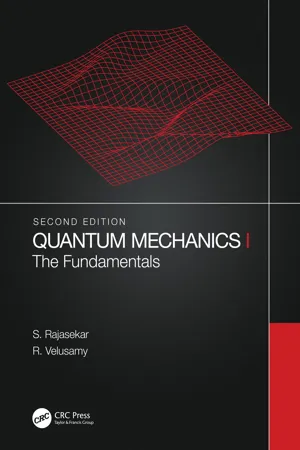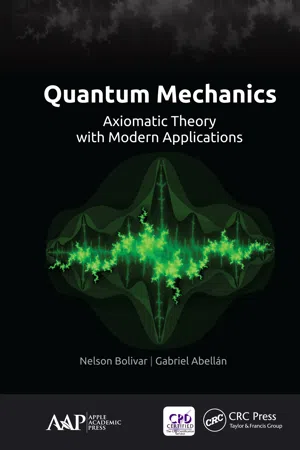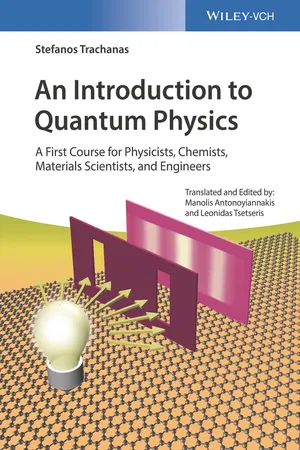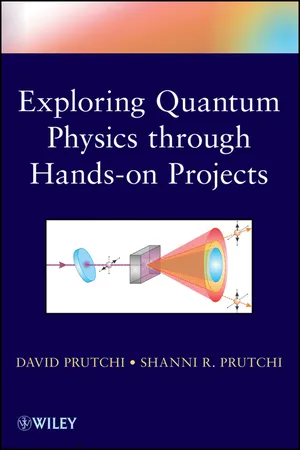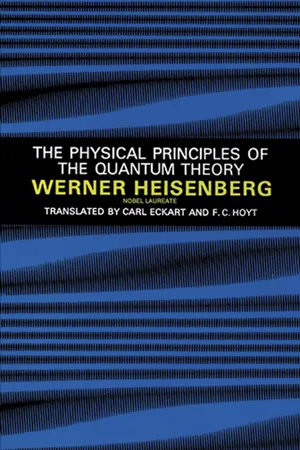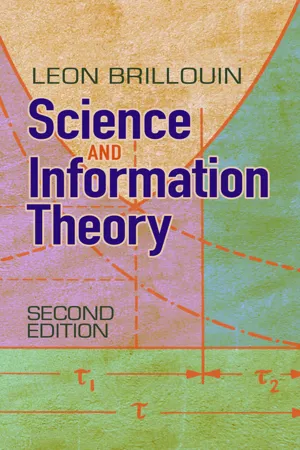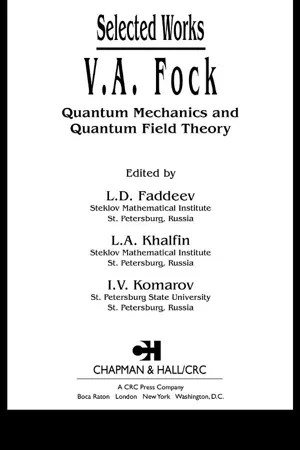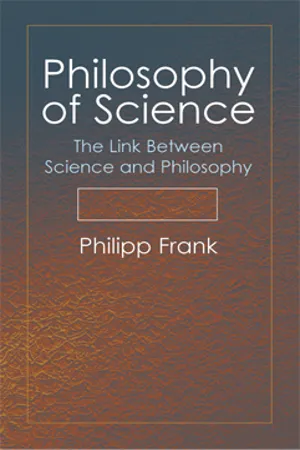Physics
Uncertainty Relations in Quantum Mechanics
Uncertainty relations in quantum mechanics, such as the Heisenberg uncertainty principle, describe the limitations on the precision with which certain pairs of physical properties of a particle can be simultaneously known. These relations imply that the more precisely one property is measured, the less precisely the other can be known, highlighting the inherent uncertainty in quantum systems.
Written by Perlego with AI-assistance
Related key terms
Related key terms
1 of 4
Related key terms
1 of 3
11 Key excerpts on "Uncertainty Relations in Quantum Mechanics"
- eBook - ePub
Quantum Mechanics I
The Fundamentals
- S. Rajasekar, R. Velusamy(Authors)
- 2022(Publication Date)
- CRC Press(Publisher)
It is the uncertainty principle for any pair of observables A and B. This equation with equality sign is commonly referred as the minimum uncertainty product. In Eq. (8.29) (Δ A) 2 = 〈 A 2 〉 − 〈 A 〉 2 (8.30) is variance in A. Similarly (Δ B) 2 is defined. For a canonically conjugate pair of operators A and B we have [ A, B ] = i ℏ. Hence, (Δ A) 2 (Δ B) 2 ≥ ℏ 2 / 4 (8.31) or (Δ A) (Δ B) ≥ ℏ / 2. (8.32) Thus, the statement of the uncertainty principle is the following: The value of both the observables of a canonically conjugate pairs of a quantum mechanical system cannot be specified precisely and simultaneously. The crucial word here is simultaneously. The uncertainty relation gives the lower bound on the product of the uncertainties of two pairs of variables. But it says nothing about the accuracy with which individual observables can be measured. An important point is that the uncertainty relation has nothing to do with the precision of the measuring instrument or technique. Rather, it is an inherent characteristic of the quantum mechanical systems. The uncertainty relation is not obtained based on experimental data. Without the uncertainty principle, quantum mechanics becomes a deterministic theory. __________________________ 1 This principle was enunciated by Heisenberg when he was just 25 years old. Because [ x, p x ] = i ℏ, the position-momentum uncertainty principle. is (Δ x) (Δ p x) ≥ ℏ / 2, (8.33) where (Δ x) 2 = 〈 x 2 〉 − 〈 x 〉 2, (Δ p x) 2 = 〈 p x 2 〉 − 〈 p x 〉 2. (8.34) (Δ x) 2 and (Δ p x) 2 are the variance of position and momentum of a particle, respectively. Note that only the mean values of x and x 2 are needed to compute Δ x. The uncertainty principle always has members of a conjugate pair. The position-momentum uncertainty relation was first called as indetermination principle by Arthur Edward Ruark [ 4 ] and then as uncertainty principle by Edward Uhler Condon [ 5 ] - eBook - ePub
Quantum Mechanics
Axiomatic Theory with Modern Applications
- Nelson Bolivar, Gabriel Abellán(Authors)
- 2018(Publication Date)
- Apple Academic Press(Publisher)
Chapter 2The Wave Function, Expectations Values, and Uncertainty
2.1 The Foundations of Quantum Mechanics2.1.1 Uncertainty Principle
The uncertainty principle, formulated by Heisenberg in 1927, is a fundamental principle in quantum mechanics. It forces us to review key concepts of classical physics, and from this analysis are born the concepts of quantum physics.The principle states that in any physical system simultaneous measurement of two canonical conjugate variables q and p is subject to an intrinsic limitation of accuracy. If we denote with Δq and Δp inaccuracies of the two measures separately, they are related by the relation of indeterminacy,(2.1)To justify this on physical basis, several experimental ideas have been proposed, for example, the Heisenberg’s microscope.Δ p Δ q ≥ ħImagine you want to measure the x coordinate and momentum p of an electron along the direction of motion. Suppose we know exactly the value of p before the measurement and want to determine x by observing the electron with a microscope, i.e., illuminating it with a beam of light thathas a given direction and wavelength. Suppose a single photon being scatter by the electron at a point P and passing through the lens is focused at the point Q of a photographic film. The inaccuracy of measurement of x is at least equal to the resolving power of the microscope, which is given by,λ(2.2)Δ x ≈λsinαwhere α is the tilt of the cone subtended by the lens section at point P . On the other hand the photon going from P to Q can start from P in any direction within that cone and this leads to uncertainty on the Δqx, the x component of the pulse. If the photon impulse module is q and qxits component along x , Δqx - eBook - ePub
An Introduction to Quantum Physics
A First Course for Physicists, Chemists, Materials Scientists, and Engineers
- Stefanos Trachanas, Manolis Antonoyiannakis, Leonidas Tsetseris(Authors)
- 2017(Publication Date)
- Wiley-VCH(Publisher)
That is, we wish to understand its physical and mathematical origin and unravel its physical consequences. After all, what makes the uncertainty principle so fundamental—indeed, the “trademark” of quantum theory—is not so much whether it is an independent or a derivative principle, but its central role in understanding the theory itself and, more importantly, the world around us. We discuss first the position–momentum uncertainty principle and then proceed to examine its time–energy counterpart. 3.2 The Position–Momentum Uncertainty Principle 3.2.1 Mathematical Explanation of the Principle It is not difficult to bring to light the mathematical mechanism behind (3.1). First, we recall that the quantities and for a particular wavefunction can be calculated from the familiar statistical expressions The values on the right-hand side can be obtained by applying the quantum mechanical formula for the mean values of the position and momentum operators. In the following, we will simplify our discussion by assuming that the wavefunction is real. We then have and 3.2 as we already showed in Example 2.5. Equation (3.2) tells us that the momentum uncertainty is a rough measure of the slope values of the wavefunction. The steeper the wavefunction, the greater the uncertainty in the particle's momentum. On the other hand, we already know that the position uncertainty is a measure of how narrow or how broad a wavefunction is. The narrower the wavefunction, the smaller is, and vice versa: The uncertainty in the particle's position is greater for a broader wavefunction. The mathematical mechanism behind the uncertainty principle begins to emerge. If we wish to lower the uncertainty in the position of a particle, we need to “employ” a narrow and (consequently) tall wavefunction, since the area under the square of must always be unity. But a “thin” wavefunction has necessarily high slope values—it goes up and down very abruptly—so the uncertainty in momentum is also high - Volodymyr Krasnoholovets(Author)
- 2017(Publication Date)
- Apple Academic Press(Publisher)
137 ] has stated that, concerning the refutation of Heisenberg’s uncertainty regarding photons: “NASA has developed a timer system accurate to 10 femtoseconds, with projections of improvements into the.001 femtosecond regime. Emission time is then not an issue over a premeasured course and thus location of the photon is known to within the accuracy limits of the timer. We can know momentum with certainty because the momentum of a photon is directly related to its frequency. If you know the frequency, you know the momentum. The other parameters mentioned above follow along similar lines. Thus, contrary to Heisenberg, I can know both the momentum and the position of the photon simultaneously, with absolute accuracy.”Dumitru [138 ] examined a number of possible applications of uncertainty relations and came to the conclusion that they do not have any crucial signifcance for physics. Moreover, he fnished his paper with words by Dirac [139 ]: “uncertainty relations in their present form will not survive in the physics of the future.”Besides, we have to mention the phenomenon of quantum entanglement: a pair or particles interacts in such a way that the quantum state of each particle cannot be described independently—instead, a quantum state is given for the system as a whole. Measurements ofphysical properties of entangled particles (position, momentum, spin, polarization, etc.) show the whole correlation. It would seem pointless to qualify these words here with source references as they have already become abundant in academic publications. At last, on the web site of CODATA (http://physics. nist.gov/cuu/Constants/index.html), internationally recommended values of the fundamental physical constants have been defned with extreme accuracy and the uncertainty principle did not in any way aff ect these fnal defnitions.All the arguments above allow us to state that the uncertainty principle must be refuted forever.3.3 THE PHASETRANSITION FROM SCHRÖDINGER’S TO DIRAC’S
The Schrödinger wave equation considered in Chapter 2 is specified with the frequency, which is given by a particle having the kinetic energyv = mU/02( 2 h ), wheremv/ 202m =m 0/1 -υ/02c 2- David Prutchi(Author)
- 2012(Publication Date)
- Wiley(Publisher)
symbol means in other books and papers on quantum physics.Heisenberg’s Uncertainty Principle was published in a 1927 paper that argued why the position and momentum of a particle cannot both be measured exactly, at the same time, even in theory. For Heisenberg, and later for the whole physics society centered on Bohr’s Copenhagen school, the very concepts of exact position and exact momentum together, in fact, had no meaning in nature.Please note that the uncertainty in the measurement of either position or momentum is not due to lack of accuracy of our measurement instruments. The compromise in the measurements happens in principle, as a law of nature. That is, even if your measurement instruments are infinitely precise, you cannot simultaneously know the position and momentum of a particle with absolute precision. For this reason, some people prefer to call this concept the Indeterminacy Principle, so that the intrinsic indeterminate character of nature is implied.Notice, however, that the limitation is in the order of magnitude of Planck’s constant h. In fact, since we are dividing it by 4π, it is one order of magnitude lower than Planck’s constant. This means that the Uncertainty Principle doesn’t really affect our everyday experience, in which momentum is so much larger than Planck’s constant.EXPERIMENTAL DEMONSTRATION OF THE UNCERTAINTY PRINCIPLE
A demonstration of the Uncertainty Principle is simple to conduct using a laser pointer and an adjustable slit consisting of two razor blades. The idea is that the photons emitted by the laser travel without diverging. As shown in Figure 104 , the photons exiting the laser can be assumed to have momentum only along the x axis (so py- eBook - ePub
- Werner Heisenberg(Author)
- 2013(Publication Date)
- Dover Publications(Publisher)
Thus suppose that the velocity of a free electron is precisely known, while the position is completely unknown. Then the principle states that every subsequent observation of the position will alter the momentum by an unknown and undeterminable amount such that after carrying out the experiment our knowledge of the electronic motion is restricted by the uncertainty relation. This may be expressed in concise and general terms by saying that every experiment destroys some of the knowledge of the system which was obtained by previous experiments. This formulation makes it clear that the uncertainty relation does not refer to the past; if the velocity of the electron is at first known and the position then exactly measured, the position for times previous to the measurement may be calculated. Then for these past times Δ p Δ q is smaller than the usual limiting value, but this knowledge of the past is of a purely speculative character, since it can never (because of the unknown change in momentum caused by the position measurement) be used as an initial condition in any calculation of the future progress of the electron and thus cannot be subjected to experimental verification. It is a matter of personal belief whether such a calculation concerning the past history of the electron can be ascribed any physical reality or not. a) Determination of the position of a free particle. – As a first example of the destruction of the knowledge of a particle’s momentum by an apparatus determining its position, we consider the use of a microscope. 6 Let the particle be moving at such a distance from the microscope that the cone of rays scattered from it through the objective has an angular opening ε. If λ is the wave-length of the light illuminating it, then the uncertainty in the measurement of the x -co-ordinate (see Fig. 5) according to the laws of optics governing the resolving power of any instrument is: F IG - eBook - ePub
Science and Information Theory
Second Edition
- Leon Brillouin(Author)
- 2013(Publication Date)
- Dover Publications(Publisher)
CHAPTER 16 INFORMATION THEORY, THE UNCERTAINTY PRINCIPLE, ANDPHYSICAL LIMITS OF OBSERVATION 1. General RemarksWe have discussed a variety of experiments, and we have obtained a general result : the negentropy principle of information, which says that any information resulting from a physical observation must be paid for by an increase in entropy in the laboratory. On the average, this entropy increase is larger than the information obtained when both quantities are measured in the same system of units. These conditions represent a new limitation on the possibilities of observation, and we want to compare it with the well known uncertainty relations.There has been a great deal of discussion, during the last half century, on the relations between classical physics and quantum physics. The original point of view of N. Bohr, expressed in his principle of “complementarity” ‘ and his interpretation of the uncertainty relations, seems to remain the sound and logical approach to the problem. Recent discussions1 have clearly emphasized the importance of the questions involved. Physics starts, historically and actually, on the classical level, with experiments made at the human scale, and fundamental definitions (length, time, mass, general laws) based on these experiments. From this solid ground, the physicist proceeds to the investigation of atomic problems and discovers the quantum conditions, with all the limitations involved in the uncertainty principle, and wave mechanics. Consistency requires that these new laws should, in the limit of very large quantum numbers, reduce to classical laws. Bohr emphasized repeatedly the fact that a measuring apparatus is always described in classical terms, but he also introduced the “correspondence principle,” according to which quantum laws must lead to classical laws in the limit, when Planck's constant h - eBook - ePub
V.A. Fock - Selected Works
Quantum Mechanics and Quantum Field Theory
- L.D. Faddeev, L.A. Khalfin, I.V. Komarov, L.D. Faddeev, L.A. Khalfin, I.V. Komarov(Authors)
- 2004(Publication Date)
- CRC Press(Publisher)
OCK AND N. KRYLOV (Received 29 May 1946)JETP 17, N 2, 93, 1947J. Phys. USSR 11, N 2, 112, 1947 (English version)Introduction
The physical meaning of the uncertainty relation between time and energy appears to be not completely clear until now. This fact is not surprising since the interpretation of the time–energy relation is much more difficult than the interpretation of the similar relation between the coordinate and momentum. Indeed, the latter relation is easily derived from the quantum-mechanical formalism and does not require the examination of the course of the physical process in time. The relation between time and energy, however, essentially requires such an examination, and there arises a question whether Schrödinger’s equation may be used or not in deriving this relation, the latter possibility being not excluded since the relation may be interpreted to correspond to a measurement act, which does not obey Schrödinger’s equation.L. Mandelstam and Ig. Tamm in their recent paper (The Uncertainty Relation between Energy and Time in Non-Relativistic Quantum Mechanics) [1] made a very interesting attempt to derive the abovementioned uncertainty relation from the Schrödinger equation.The aim of the present note is to analyze the relation derived by these authors. At first we shall consider the uncertainty relation in its usual (Bohr’s) interpretation and compare it with the relation derived by Mandelstam and Tamm. We shall find that the meaning and regions of application of these two relations are entirely different. In the last section we shall establish a connection between the law of decay of an almost stationary state and the energy distribution function in this state and consider the question on the practical applicability of the Mandelstam– Tamm relation to this problem. - eBook - ePub
Philosophy of Science
The Link Between Science and Philosophy
- Philipp Frank(Author)
- 2013(Publication Date)
- Dover Publications(Publisher)
9 The New Language of the Atomic World 1. Heisenberg’s Uncertainty Relation 1 The laws of motion for small particles are formulated 2 in such a way that they connect observable initial conditions with observable results; the laws say nothing about “moving” particles. The scientist has always felt the need for retaining the traditional laws of motion as long as possible. They have been absorbed by our common-sense language, and it is certainly very helpful to use this same language as much as possible. In using common-sense language, the imagination of the scientist works with more ease and detachment than in using an abstract language where every result must be found by step-by-step formal reasoning. If we again consider the swarm of particles passing through the diaphragm through two slits S 1 and S 2, we can describe the situation in the following way: A wave passes through both slits and produces interference on the other side. To say that one particle passes through both slits would be an odd way to speak about a small particle ; therefore, one would do better to say that the particle passes through the diaphragm, but that the exact location of its passing is described by an uncertainty a because the distance between the slits through which it passes is a. In Newtonian mechanics, the initial conditions of motion are the position (coordinate) and velocity (or momentum). If these data are given, we can predict the future motion from Newton’s laws of motion - M.B Mensky(Author)
- 2017(Publication Date)
- CRC Press(Publisher)
9.12 ).The principal distinctions of this new uncertainty principle from the Heisenberg uncertainty relation should be emphasized. The latter restricts the variance of outputs of two different measurements (for example of position and momentum). But the output of a continuous measurement contains information about both position and momentum (or any other pair of conjugate observables). Therefore some restriction should arise on the variance of outputs of this measurement alone. This restriction is expressed by AUP. It turns out that (in the quantum regime of measurement) the more accurate the continuous measurement, the more its outputs can differ from those predicted by classical theory, as can be seen from equation (9.12) .The qualitative consequences of this principle arising in a typical situation can be formulated as follows:1. For a rough measurement (when the error of the measurement is large and the sets α wide) only those measurement outputs are probable which are predicted by classical theory. This is a classical regime of measurement.2. For a fine measurement (when the error is small and the sets α narrow) even those measurement outputs that are far from classical predictions are probable. The more precise the measurement, the wider is the range of probable measurement outputs (this may be called quantum measurement noise). This is a quantum regime of measurement.3. The optimal regime lies between the classical and quantum regimes of measurement. Rougher measurements are inefficient because of classical measurement errors. Finer measurements are inefficient because of the quantum measurement noise.This leads to an absolute restriction on the measurability of the corresponding observable. This restriction cannot be overcome by the choice of the measuring device for the same type of measurement. One can, however, choose the type of measurement or the observable to be measured in such a way that an absolute restriction does not arise. In this case the observable and the measurement are called quantum nondemolition (QND). For any such measurement there is in fact no quantum regime of measurement.- eBook - ePub
The Language of Modern Physics
An Introduction to the Philosophy of Science
- Ernest H. Hutten(Author)
- 2022(Publication Date)
- Routledge(Publisher)
To illustrate the situation, let us take once more the simple diffraction experiment. If we describe the electrons as a wave, then the events at the slit are explained in the normal manner; for we are accustomed to account for diffraction in terms of the wave model. But, then, we must keep to this interpretation when we speak about the events on the screen: we must speak about the maxima and minima of the diffraction pattern. However, we are inclined here to change over to the particle interpretation, for we see the pattern as scintillations ; and these flashes of light are more normally interpreted as electrons impinging upon the screen. If we mix our languages in this manner, we arrive at a difficulty. We are forced to say that the extended wave front coming from the slit has suddenly contracted into a point here, or a point there, and these points are seen as flashes. In other words, we violate the principle of causality, according to which transmission of action—the contraction of the wave into a point—must take a finite time. Classical physics, and particularly relativity theory, has always required that cause and effect are linked by an action-by-contact. Similar difficulties would occur if we were to use the particle interpretation, originally, and then change over to the wave language ; this becomes more obvious when we describe a double-slit experiment. The various happenings of one and the same experiment must be described in terms of one concept alone. Although one description may be more convenient or natural to use for a particular part of the experiment, we cannot use both interpretations at the same time. This prohibition is formulated by the complementarity principle.If we disobey this principle, we find what has been called by Reichenbach a causal anomaly : our usual conception of causality is violated. We must never say in quantum mechanics that waves cause particles, or vice versa. We can formulate the causal relation between two events only if these events are described within the same language-system ; for a law is a theorem within a theory.It must be noted that these anomalies are not due to the revision of the concept of causality which is required by the uncertainty principle ; though we have to change from the determinism of classical theory to a statistical causality this is separate difficulty. Since the discussion of the uncertainty principle is important for our understanding of causality, this problem will be taken up later.The difficulty regarding complementarity is mainly linguistic. The concepts of wave and particle, however modified they are in quantum mechanics, are still endowed with some characteristics of classical theory, and we have therefore to take care when we interpret micro-physical phenomena with their help. There are certain semantic rules of usage for ‘wave’ and ‘particle’ which we cannot give up completely without playing havoc with our language. These rules work well enough when we describe macro-physical phenomena ; but their insufficiency is revealed in micro-physics.As a matter of fact, the complementarity of a pair of concepts occurs also in classical physics. It is only because there we are hardly ever tempted to misuse them—the phenomena are familiar and directly observable—that the complementarity does not show up so clearly as in quantum mechanics. It is always preferable not to use these two concepts simultaneously. This is borne out by the historical development of the theory of light, with the rival claims of Newton and Huygens. When we say that a stone thrown into a pool of water produces waves, we may think that this illustrates how events described by these two different concepts can be causally related. But classical physics is more cautious in formulating causal statements than ordinary language. We say that the stone—a particle—sets the particles of water, or the water molecules, into motion ; and this motion as a whole is then described as a wave pattern spreading over the (continuous) surface of the water. Another example, the experiment on the pressure of light, might be thought to illustrate the reverse : we say, on occasion, that waves set particles in motion. But, again, classical theory prefers a different formulation. We introduce the concept of the energy of the wave ; and we express the energy in terms of elasticity, as stress and strain of a medium, so that we can keep within a continuum picture or field theory. Many such examples could be found. Admittedly, their explanation is somewhat vague. But we see that even in classical physics causal relations are not so simple as they appear and that we must choose carefully the language in which to describe them.
Index pages curate the most relevant extracts from our library of academic textbooks. They’ve been created using an in-house natural language model (NLM), each adding context and meaning to key research topics.
Explore more topic indexes
Explore more topic indexes
1 of 6
Explore more topic indexes
1 of 4
